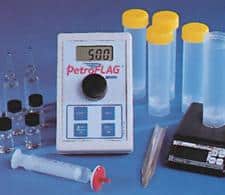
Manufacturer: Dexsil
Part Number: PF-MTR-01
Order / Quote
Relying on laboratory methods to determine hydrocarbon contamination in soil is both time consuming and expensive. Laboratory methods, such as EPA Method 8015, are very expensive and have turnaround times of one to two weeks. Most samples analyzed by this method limit the results to Gasoline Range Organics (GRO) or Diesel Range Organics (DRO). When limiting the analysis to these two ranges, heavier fractions of hydrocarbons such as fuel oil, motor oil, hydraulic oil, gear oil, transformer oil and greases are "not seen" in the analysis and the soil samples are reported as clean even though these heavier hydrocarbons still exist in the soil.
Method 418.1 was the only broad spectrum "Total Petroleum Hydrocarbon" field test for soil. Although this test is quite accurate for dry soils, the extraction efficiencies for wet soil can be as low 10%. This inability to solvate wet soil samples can lead to false negative results. Method 418.1 also uses a chlorinated solvent (Freon) as its extraction solvent. Freon is environmentally unsafe, and its disposal costs are quite high.
The analyst now has another choice; an environmentally safe, inexpensive, field portable test called PetroFLAG. The PetroFLAG system is a field portable method for the determination of total petroleum hydrocarbons in soil. It is both safe and easy to use. PetroFLAG does not distinguish between aromatic and aliphatic hydrocarbons, but quantifies all fuels, oils, and greases as total hydrocarbons. Analysis of a 10 gram soil sample is performed using three simple steps: extraction, filtration, and analysis.
The PetroFLAG system is completely field portable. Everything needed to perform ten soil tests can be conveniently carried to the job site in a briefcase size carrying case. The PetroFLAG meter is a light-weight, rugged hand-held unit powered by a 9-volt alkaline battery. The meter is menu driven for ease of use and utilizes an EEPROM memory system. Fifteen response factors are built into the analyzer depending on the analyte of interest. Response factors correlate to fuels ranging from weathered gasoline to heavy crude oil. The results are shown in ppm on an LCD display screen.
PetroFLAG has been assigned a USEPA SW-846 Draft Method 9074.